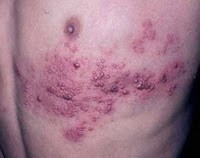

Ringworm is very common, especially among children, and may be spread by skin-to-skin contact, as well as via contact with contaminated items such as hairbrushes. Ringworm spreads readily, as those infected are contagious even before they show symptoms of the disease. Participants in contact sports such as wrestling have a risk of contracting the fungal infection through skin-to-skin contact.
A number of different species of fungi cause ringworm.
The best known sign of ringworm in people is the appearance of one or more red raised itchy patches with defined edges, not unlike the herald rash of Pityriasis rosea. These patches are often lighter in the center, taking on the appearance of a ring. If the infected area involves the scalp or beard area, then bald patches may become evident. The affected area may become itchy for periods of time. If the nails are affected, they may thicken, discolor, and finally crumble and fall off.
Some of the fungi fluoresce under a black light examination.
In domestic animals, ringworm can cause a variety of symptoms, but most cases show scaling and patches of hair loss. Some cats can be carriers, but show no symptoms.
Topical antifungal drugs containing miconazole and clotrimazole, available by prescription or over the counter, are used to clear up the infection. Fungal infections can take weeks or months to clear up.
Terbinafine is highly effective for Tinea corporis. It treats itching, burning, cracking, and scaling that accompany this condition. It cures most ringworm except the types affecting the nails or scalp, which are very difficult to treat.
Griseofulvin is another antifungal drug that can be used to treat ringworm. It can be very effective, but may produce side effects.





